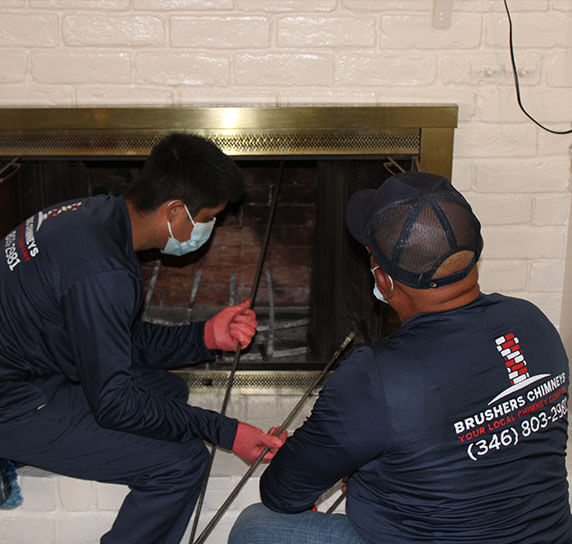At Brushers Chimneys we are one of few chimney companies in Houston to offer a Free inspections. They are not just free, but we offer a full inspection for your entire chimney. Ensuring we keep your fireplace and chimney working safely and properly for years to come.
We have outlined the categories of an inspection below. When we complete your inspection, we provide you with pictures and an organized report along with a free estimate.. No strings attached.

The inspector will begin by looking at the fireplace. Is there damage to the unit, like cracks in the fire box? Are there any obstructions preventing the fireplace from burning properly? An unkempt fireplace will create an unsafe fire. The best case scenario means it will burn less efficiently. At worst, it will send smoke into your home.
The damper regulates the flow of air and smoke through the chimney. Inspection of the damper checks that it opens, closes, and seals. A defective damper can cause loss of energy and poor ventilation.
Creosote is made when people burn wood, and it accumulates inside the chimney. The inspector will look for the different stages of creosote buildup:
Stage 1: A light, flaky layer that can be easily brushed off.
Stage 2: A harder, more tar-like substance that requires more effort to remove.
Stage 3: A dense, hardened layer that is extremely flammable and difficult to remove. The fireplace should not be used until the creosote is removed.
The chimney stack or flue is the vertical shaft that lets smoke and fumes out of your home. Inside the flue, inspectors look for cracks, obstructions or signs of decay. A damaged flue can cause carbon monoxide to leak inside your home or lead to a fire.
The inspector will examine the outside bricks for cracks, spalling (flaking), and missing mortar. Even a small amount of damage could mean expensive repairs if left unattended.
Refractory panels surround the walls of the firebox. They protect the rest of the structure from the intense heat of a fire. With each chimney inspection, technicians look for cracks, gaps or wear in these panels. Panel damage makes your fireplace less efficient and increases the potential for fire spread outside the firebox.
Flashing is the metal material that seals the space between the chimney and the roof, keeping water out of your home. A chimney inspection will check for rust, damage, or improper installation. Leaking flashing is one of the most common causes of chimney leaks, and chimney leaks can create water damage in your home.
The plywood and shingles around the chimney will be checked for signs of water damage, rot, or wear. These components are important for keeping the chimney sealed against water.
A chimney cricket is a small, peaked structure that is built behind the chimney and helps divert water and debris away from the chimney. On inspection, typically the chimney cricket is checked to make sure it is installed and undamaged. If a chimney cricket becomes damaged or missing, water can start pooling around the chimney, which can lead to an increased chance of leaks developing.
The siding or trim that encloses your chimney will be examined for rotting, warping, or other evidence of damage. Any damage to the siding or trims can allow water and pests to get inside the chimney, which can cause decay.
The chase top, which is the lid you see at the top of a pre-fab or factory-built chimney, is inspected for rust, cracks or other damage that can allow water to enter the chimney stack. If the chase top is compromised, it will lead to rust and water damage.
The chimney cap prevents rain, debris and animals from entering the flue. Chimney caps are inspected to make sure they’re installed properly and are in good condition. Missing or damaged chimney caps can cause blockages and leaks. They can also let animals enter and nest inside the chimney.
Call To Schedule (346) 803-2981

15 years of home ownership, I figured it was time to cover all my bases. Brushers sent their Austin crew
Chimney inspection is not something that can be done by anyone. You need a professional who is well-versed and trained in chimney sweeping, cleaning, and analyzing. They should follow the Chimney Safety Institute of Americas guidelines. Because The CSIA is who determines the procedures conducted for chimney inspection.
You want to hire someone who can remove flammable substances such as creosote, which can cause chimney fires. You also need someone who can remove objects of obstruction such as birds nests.
Some common warning signs that you may be at risk for a chimney fire include:
Your inspector should be able to recognize all of the warning signs in order to prevent a significant disaster from occurring.
A pro will inspect your chimney from top to bottom and notify you if there are any substances that need to be removed.
These may include flue obstructions, creosote buildup, or other debris.
If you need an inspection, you can always rely on our team to do the following:
Chimney inspection is a safety step you should take every year and it should not be an option. inspection means you will have regular sweepings, cleanings, and video surveillance.
These are what ensure your chimney is in safe working order.
Avoiding chimney inspections can result in a fire or other health issues due to blockage and buildup.
Contact our team to schedule your free and full inspection today.

We offer trustworthy & reliable chimney sweep service to thousands of satisfied customers in Houston and surrounding areas.

We are top trained professionals with experience in chimney sweeping, repair, and maintenance.

Guaranteed cleaning and repairs.

You can trust and hire Brushers Chimneys as we offer top notch service quality at a very competitive rate.

Houston’s top-rated chimney cleaning company on Google with thousands of satisfied customers.
Hire us for Chimney Inspection, Sweep, and Repair in Houston, San Antonio,
Austin, Dallas, and surrounding neighborhoods. Call us today to see
if we service your area!

10103 Fondren Rd #375, Houston, TX 77096